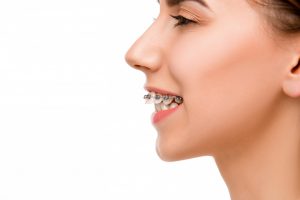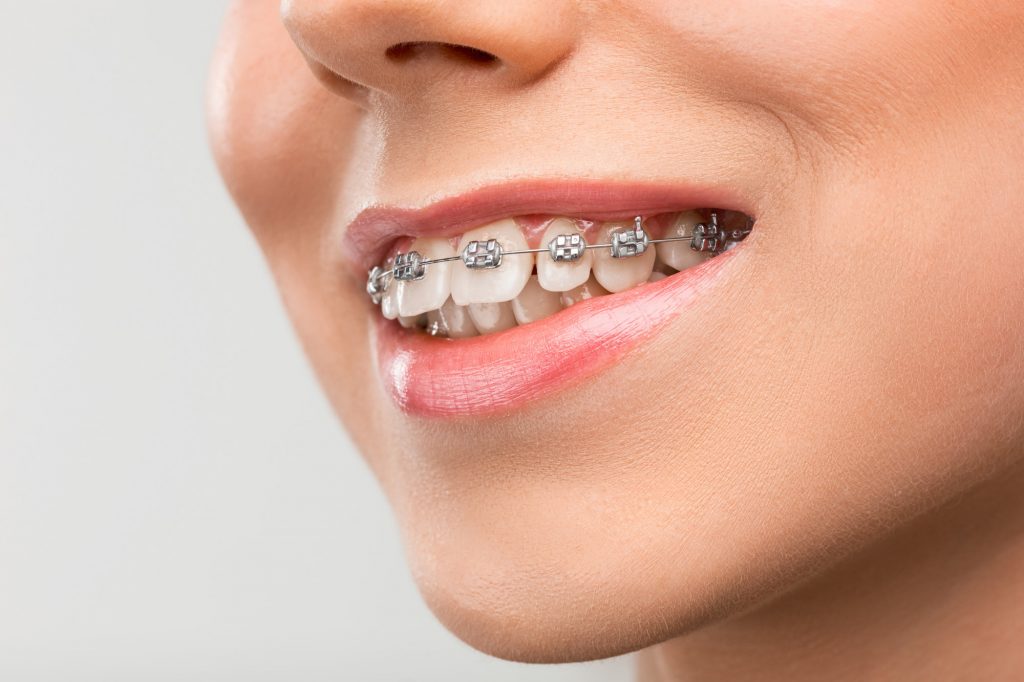What Are Dental Braces?
Orthodontic treatment is a specialized dental treatment which corrects misaligned (crooked, rotated or crowded) teeth, improper bites or abnormal jaw alignments. The most common device used in orthodontic treatment is Braces, which is used to straighten misaligned teeth and improper biting positions. Thus, Braces are used not only for aesthetic but also functional purposes.
Dental braces can be placed on individuals of all ages, from teenagers to the elderly. However, Dentists most commonly recommend treatment between the pre-teen and teenage years since the jaw bone is flexible at this time and it’s easier to move the teeth without complications.
How do Braces function?
Since each case is different, orthodontic braces work differently on each individual, depending on the initial tooth positions, jaw alignment and results to be achieved. Different components of the Braces perform different functions and ultimately band together to achieve a beautiful smile over time. The seven main components of Braces are:
Bracket
Brackets are small, square-shaped, metallic or ceramic components glued onto the front of the teeth and used to support arch wires that push the teeth into the desired positions during orthodontic treatment.. A special bonding agent is used to glue the brackets to the center of each tooth. Sometimes, brackets may be placed on the back of the tooth, depending on the patient’s needs.
Archwire
Arch wires pass through slots in the centre of the brackets and can be metallic or transparent. They apply small but steady pressure on the teeth and push them into the desired positions to achieve an optimal smile. Arch wires come in varying sizes so that varying amounts of pressure can be applied on the teeth, as the case demands.
Ligature Elastic
These are tiny rubber bands that help keep the arch wires in place and hold them close to the brackets. They contribute in guiding the teeth to their desired positions and must be replaced by the orthodontist at every appointment as they lose elasticity over time. Elastic ligatures are available in various colors and can be picked by patients depending on their color choice.
Chain Elastic
Power chains, elastic chains or c-chain ligatures are many connected elastics that are used to increase the pressure being applied on the teeth to move them in a certain direction. They are used to move the teeth quickly, especially while closing gaps.
Ligature Wire
Ligatures wires, thin stainless wires, have similar function to ligature elastics. They keep the arch wire firmly in the bracket slots. Ligature wires also provide greater flexibility and strength when compared to ligature elastics and can be used to achieve quick results.
Spring Coil
Two types of coil springs are available- open and closed coil springs. Open coil springs are used to open up or create some space between two teeth. Closed coil springs are used to close the gap between two teeth.
Rubber Band
Rubber bands are very important for aligning the bite and jaw during orthodontic treatment. They connect brackets in the upper jaw to the lower jaw and are usually placed during the later stages of the treatment. They attach to hooks glued onto the teeth.
What are the Types of Dental Braces
Braces can be of many types – from metallic and clear ones to those placed on the front surfaces of teeth and those placed on the back surfaces of teeth. Metallic ones are the most commonly used ones, but for better aesthetics, ceramic braces or invisible braces (Invisalign) can be used. Mainly, there are four types of braces:
Metal Braces
Metallic braces are the most traditional and reliable type of braces in the market. They are quite affordable compared to other orthodontic braces and bring about a quick correction of the misaligned. Metal braces can fix a variety of orthodontic cases, from simple to complex. Bite abnormalities, crowded teeth, crooked teeth and gap teeth, can all be corrected with these braces. Children and teens usually opt for metal braces, whereas adults can opt for ceramic or clear braces if they are concerned about aesthetics during the entire treatment period.
Clear Braces
Clear braces consist of ceramic brackets which are tooth colored and blend in with the natural teeth. They are a discrete alternative for individuals who do not want the usual “Metalhead mouth” that we see with metallic braces. They also have thin metal wires coated with tooth colored plastic material to make the whole bracket system less obvious to the eye. Elastic Ligatures and Rubber Bands used may also be clear and transparent. Adults and teens concerned about their appearance can decide to go with clear braces.
Lingual Braces
Lingual braces are another alternative to the traditional metallic braces. Here, the metal brackets and wires are placed on the back surfaces or “insides” of the teeth, instead of the front surfaces, so they are practically invisible to onlookers. All the components are exactly the same as regular metal braces.
Invisalign
Invisalign, also called clear aligners, uses a series of 20-30 clear or transparent trays to move the teeth slowly into their proper positions. They are a popular alternative to metal braces. Clear aligners are slightly more expensive than metallic braces and take a somewhat longer time to achieve the desired results. The trays are fabricated after creating 3-D impressions of the patient’s jaw and teeth using radiographs and digital photographs. Each tray must be worn for at least 3-4 weeks, after which the patient can move on to the next tray. Therefore, the number of visits to the orthodontist are limited. However, Invisalign is used to correct only mild-to-moderate misalignment in teeth and is not ideal for complex cases. Patients can remove them at will whenever they want to brush, floss, eat or attend special events.
Braces with Headgear
Orthodontic headgear are devices that are used to treat jaw abnormalities and bite problems. The appliance consists of components like extra-oral wires, straps and chin cups which may be connected to the intra-oral braces. The device is usually necessary only in complex cases of overbite, underbite, crossbite or open bite. The headgear influences the growth of jaw bones and can be used only on children since their jaws are still growing.
Placement of Dental Braces: Step-by-Step procedure
1. Consultation
Once a consultation has been booked, the Orthodontist will perform a thorough checkup of the teeth and surrounding structures. Relevant photographs, X-rays and bite impressions may be taken before the orthodontist decides on the best treatment plan for the patient.
2. Before Treatment
Before every orthodontic treatment, scaling or tooth cleaning must be performed to remove any lodged food debris or calculus. Any other dental treatment like fillings, extractions, or periodontal management must be completed before initiating the orthodontic treatment. It should be noted here that periodontally compromised or teeth that are moving are not eligible for ortho treatment.
3. First Appointment
Full mouth X-rays and bite impressions of the patient are taken, and custom molds are created out of them. The treatment is planned using the patient’s measurements and suitable bracket components are picked out.
4. Placement of Braces
Actual placement of the braces rarely takes long. The orthodontist will first clean and dry the teeth, place a special adhesive or bonding agent on the bracket, and bond the bracket to the teeth using a UV light source. This hardens the adhesive and bonds the bracket firmly to the tooth. Last, the orthodontist will pass the arch wire through the bracket slots and place the necessary ligatures (elastic or wire) to keep the arch wires in place.
5. Monthly Recall Appointments
The patient is called for the first follow-up appointment after 4-8 weeks. The orthodontist will check the direction of movement of the teeth and make any adjustments required to the ligatures or wires. He may additionally tighten the arch wires. After that, an orthodontic appointment will be scheduled every month till the desired results are achieved and the treatment is complete. Braces take anywhere between 2-3 years to bring results.
6. Last Appointment
At the last appointment, the orthodontist will remove the brackets and wires using an instrument. After all the components are removed, then another round of tooth cleaning is done to remove all the adhesive from the tooth surface. A retainer is provided, which may be permanent or removable, which has to be worn for at least 6 months to prevent the teeth from going back to their original positions.
7. Post procedure care
During the ortho treatment, special care must be taken to keep the braces clean and maintain good oral hygiene. Brushing and flossing is recommended after every meal, using special orthodontic brushes and interdental aids. If food repeatedly gets stuck in your braces and is not cleaned off properly, bacteria will build up and result in bigger problems like decay and periodontal disease.
Benefits of getting Dental Braces
It’s easier to maintain good oral hygiene when you have teeth that are properly aligned. It is more difficult to remove plaque around crooked or crowded teeth which leads to buildup of a hard white substance called calculus. Calculus leads to development of periodontal disease or gum disease, which weakens the tooth and eventually causes them to fall out. Thus, along with improving your aesthetics, orthodontic treatment also lowers the risk of getting oral disease.
Some risk factors associated with crooked teeth include:
Tooth decay (caries)
Gum or periodontal disease (gingivitis and periodontitis)
Temporomandibular joint dysfunction (TMD)
Migraines and constant Pain in temple region due to improper bite
Painful chewing or speaking
Greater chance of wearing down enamel
Mobile teeth
Tooth loss
Dietary Considerations With Braces
It’s important to be mindful of what you eat during orthodontic treatment because certain sticky, hard or crunchy foods like candy, popcorn, nuts etc may damage the braces. Biting into anything using your front teeth is a strict no no. Gum should also be avoided since it can get stuck in the metallic brackets or wires, and fracture them.
Sugary drinks and coffee should also be avoided through the ortho treatment because it’s more difficult to clean off the sugars or stains from these drinks when you have braces. If they’re not cleaned off properly, it can cause tooth decay (cavities) and yellowing of teeth due to stains. All food must be cut into small pieces and chewed from the back teeth.
What to eat
Bread
Milk
Yogurt
Soft Fruit
Cooked Meat
Tofu
Nut Butters (Peanut, Almond)
Steamed or cooked Veggies
What to not eat
Candy
Popcorn
Hard Nuts and Seeds
Sugary drinks
Coffee/Tea
Hard Fruit
Meat with bone
Uncooked Veggies
Hard Crust Breads
How much do dental braces cost? Are they covered by Insurance?
Some states may cover the entire orthodontic treatment under dental insurance for children. However, for adults, dental insurance may cover only part of the treatment cost.
Insurance companies do not take into account whether orthodontic treatment is being carried out for aesthetic or functional purposes. In most cases, if ortho treatment is included in the dental insurance provider’s plan, they will cover the costs. If not included in the insurance plan, the treatment will not be covered.
Treatment cost for each type of braces differs according to individual case needs and length of treatment. Typically, the costs are as follows:
Consultation 400 shekels
Metallic Braces 12000 shekels
Ceramic Braces 16000-18000 shekels
Invisalign 22000-28000 shekels
(Inclusive of retainers)

